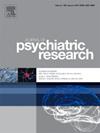Lack of social interaction advantage: A domain-general cognitive alteration in schizophrenia
IF 3.7
2区 医学
Q1 PSYCHIATRY
引用次数: 0
Abstract
People with schizophrenia (PSZ) showed preserved ability to unconsciously process simple social information (e.g., face and gaze), but not in higher-order cognition (e.g., memory). It is yet unknown how PSZ process social interactions across different cognitive domains. This study systematically investigated the cognitive characteristics of PSZ during social interaction processing from bottom-up perception to top-down memory, and established correlations with schizophrenic symptoms. In two experiments, social interactions were consistently displayed by face-to-face or back-to-back dyads. Experiment 1 enrolled 30 PSZ and 30 healthy control subjects (HCS) with a breaking continuous flash suppression (b-CFS) paradigm. Experiment 2 recruited 36 PSZ and 36 HCS for two memory tasks, wherein participants restored the between-model distance (working memory task) and recalled the socially bound pairs (long-term memory task). Results indicated that HCS showed advantageous processing of socially interactive stimuli against non-interactive stimuli throughout two experiments, including faster access to visual consciousness, closer spatial distance held in working memory and higher recollection accuracy in long-term memory. However, PSZ did not show any of these advantages, with significant interaction effects for all three tasks (task one: p = .018, ηp2 = .092; task two: p = .021, ηp2 = .074; task three: p = .015, ηp2 = .082). Moreover, correlation analyses indicated that PSZ with more severe negative symptoms (r = −.344, p = .040) or higher medication dosages (r = −.334, p = .046) showed fewer advantages in memorizing socially interactive information. Therefore, social interaction is not prioritized in schizophrenia from bottom-up perception to top-down memory, and the magnitude of such a domain-general cognitive alteration is clinically relevant to symptom severity and medication.
缺乏社会交往优势:精神分裂症的认知改变
精神分裂症患者(PSZ)表现出无意识地处理简单社会信息(如面部和目光)的能力,但不具备高阶认知(如记忆)的能力。目前尚不清楚PSZ如何处理不同认知领域的社会互动。本研究系统考察了PSZ在社会互动加工过程中从自下而上感知到自上而下记忆的认知特征,并建立了与精神分裂症症状的相关性。在两个实验中,社交互动始终是面对面或背靠背的二人组。实验1采用打破连续闪光抑制(b-CFS)模式,选取30名PSZ和30名健康对照(HCS)。实验2共招募36名PSZ和36名HCS参与两项记忆任务,其中被试恢复模型间距离(工作记忆任务)和回忆社会约束对(长期记忆任务)。结果表明,在两个实验中,高强度神经系统对社会互动刺激的加工优于非互动刺激,表现为视觉意识的获取更快、工作记忆的空间距离更近、长期记忆的回忆准确性更高。然而,PSZ没有表现出任何这些优势,在所有三个任务中都有显著的相互作用效应(任务一:p = 0.018, ηp2 = 0.092;任务二:p = 0.021, ηp2 = 0.074;任务三:p = 0.015, ηp2 = 0.082)。相关性分析表明,PSZ阴性症状更严重(r =−)。344, p = 0.040)或更高的用药剂量(r =−。334, p = .046)在记忆社会互动信息方面的优势较少。因此,精神分裂症从自下而上的感知到自上而下的记忆,社会互动并不是优先考虑的,这种领域一般认知改变的程度在临床上与症状严重程度和药物有关。
本文章由计算机程序翻译,如有差异,请以英文原文为准。
求助全文
约1分钟内获得全文
求助全文
来源期刊

Journal of psychiatric research
医学-精神病学
CiteScore
7.30
自引率
2.10%
发文量
622
审稿时长
130 days
期刊介绍:
Founded in 1961 to report on the latest work in psychiatry and cognate disciplines, the Journal of Psychiatric Research is dedicated to innovative and timely studies of four important areas of research:
(1) clinical studies of all disciplines relating to psychiatric illness, as well as normal human behaviour, including biochemical, physiological, genetic, environmental, social, psychological and epidemiological factors;
(2) basic studies pertaining to psychiatry in such fields as neuropsychopharmacology, neuroendocrinology, electrophysiology, genetics, experimental psychology and epidemiology;
(3) the growing application of clinical laboratory techniques in psychiatry, including imagery and spectroscopy of the brain, molecular biology and computer sciences;
 求助内容:
求助内容: 应助结果提醒方式:
应助结果提醒方式:


